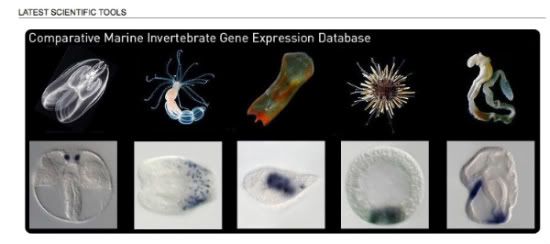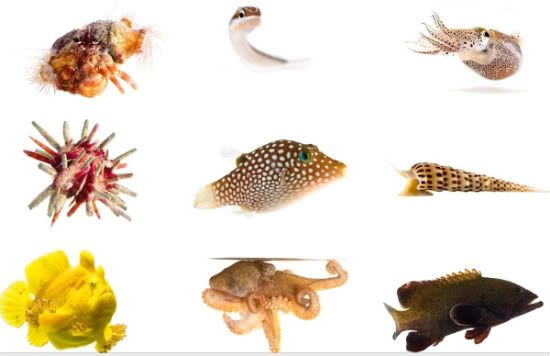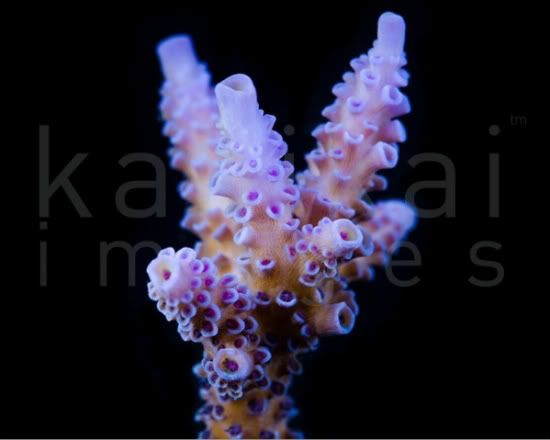
Team Science
Friday, September 9, 2011
Thursday, August 11, 2011
Why Business and Science Should Marry...
I'm one of those people who refuses to accept one major in college. I really, desperately wanted to double major with Business Management and Biology. Let's be honest, now, business and science were really made for each other. Call me a future super villain, but I totally believe that understanding the universe isn't enough. We have to control it. MUWHAHAHAHAHA.
All joking aside, business and science really should just quit making eyes at each other and get down and dirty. They could do something brilliant if they just tried.
Like create electronic circuits that are part of your skin. They're actually really cool, and appear to sit right above your skin like a nicotine patch, to hold tons of information. Or, at least, some information right now.

It's really neat! It's a lot like----
Wait a minute...
It reminds me waaaaay too much of this:

And some people say evolution isn't real.
All joking aside, business and science really should just quit making eyes at each other and get down and dirty. They could do something brilliant if they just tried.
Like create electronic circuits that are part of your skin. They're actually really cool, and appear to sit right above your skin like a nicotine patch, to hold tons of information. Or, at least, some information right now.

It's really neat! It's a lot like----
Wait a minute...
It reminds me waaaaay too much of this:

And some people say evolution isn't real.
Wednesday, July 20, 2011
Hey, Mendel!

Google Honors Gregor Mendel. Considering how much I've learned about him and his peas in the last two semesters, I heartily approve.
Saturday, July 9, 2011
Microbiology is Stupid
I've been saying this for a while. Science should be shit you can see. And maybe I just said that in order to irritate Jen.
Anyway, for all its stupidity, sometimes you-can't-see-it science can be rather pretty.

From Epic Wins.
I've got a few posts planned up for next week, and hopefully the newest collaborator to this blog, Joe, will start posting soon, too.
Anyway, for all its stupidity, sometimes you-can't-see-it science can be rather pretty.

From Epic Wins.
I've got a few posts planned up for next week, and hopefully the newest collaborator to this blog, Joe, will start posting soon, too.
Thursday, June 9, 2011
Can't Sleep, Thinking About Spiders
So I haven't been doing a lot of sleeping. I've recently gone on a new medication to treat my sexy depression, fluoxetine, a knockoff prozac. It's helped out with my depression, but I've ended up contracting a really nasty set of anxiousness side effects. Which sucks, really, as I was hoping for the common "weight loss" side effect to hit me hardcore and take care of my love handles. All the same, if I'm not super busy, I'm having a panic attack. My therapist says if these don't clear up soon we're going to try putting me on tranquilizers to sort them out (which makes me sound like some sort of bad puppy needing a shot to calm down, but I digress). Until then, I'm just doing my very best to stay as super busy as possible.
My most recent self-induced project involves something I've nicknamed "The Spider Tunnel". This is a tunnel running out to the C&O canal in Brunswick, MD. One of my friends, Carolyn, a geology major, discovered the tunnel and its plethora of tiny, eight-legged creatures. Basically, on the outside, it looks like this:

-me, with the aforementioned cute guy who did not go to Germany.
And on the inside, it looks like this:

-courtesy The Leaky Cauldron
Or, okay, like this, actually:


The spiders pretty much cover the entire ceiling from the mouth of the tunnel to about twenty-five meters in. I figure they must feed on each other and on the mosquitoes that come in from the canal. All the same, I'm absolutely fascinated by their habitat of living and the community they have in this cave.


While it's difficult to see in this shot (and next time I go in, I'm taking more than just my camera phone), there's actually a secondary orb web attached to that tangle web on the ceiling. While many spiders do live in communal webs, I haven't read too many articles on webs of different species attached to each other. I've purchased a few new books, and will be doing more research.
What particularly bothers me about the spiders should be, in theory, really simple to answer. What the hell species are they? The spider we caught a few months ago (that is sitting in alcohol on my desk as I type) was originally thought to be a trapdoor spider by one of my biology professors. From a strictly phenotypic side, I'd say yeah, it does. Most specifically, a California Trapdoor Spider.

It looks right, but there are two problems. #1: Trapdoor Spiders create trapdoors on the ground (hence the name) where little bugs can walk across them and get nommed up like whoa. The Brunswick spiders are on the ceiling of a cave in tangled webs. Also, #2: California Trapdoor Spiders live in, well, California. Not Brunswick, MD.
So, after some searching (read: three days, no sleep, internet internet internet), I think I've uncovered what these little guys are. Hacklemesh Weavers. The markings appear to be consistent on the Brunswick spiders, as do the hairy legs and the webs they make. I'm going to need to capture a few more and see what I can do to run tests on them.
It shouldn't be this difficult to figure out a spider species. I mean, they're so like so many spiders I've found in books, but they're different, too, and their behavior is odd. In my head, they've become something like a cartoon villain.

Bastards. I'll get you next time!
Oh, and in a funny aside, I was showing my co-blogger Jen (a microbiologist who thinks that science you can see isn't even remotely interesting) the way the webs were on the ceilings in her kitchen the other day when suddenly, and without warning, she hugged me.
"If anyone tells you that you shouldn't be a biologist, MJ, remember this moment," she said. "You just tried to explain web construction using a set of dish towels. THIS IS SCIENCE."
Hell yeah.
My most recent self-induced project involves something I've nicknamed "The Spider Tunnel". This is a tunnel running out to the C&O canal in Brunswick, MD. One of my friends, Carolyn, a geology major, discovered the tunnel and its plethora of tiny, eight-legged creatures. Basically, on the outside, it looks like this:

-me, with the aforementioned cute guy who did not go to Germany.
And on the inside, it looks like this:

-courtesy The Leaky Cauldron
Or, okay, like this, actually:


The spiders pretty much cover the entire ceiling from the mouth of the tunnel to about twenty-five meters in. I figure they must feed on each other and on the mosquitoes that come in from the canal. All the same, I'm absolutely fascinated by their habitat of living and the community they have in this cave.


While it's difficult to see in this shot (and next time I go in, I'm taking more than just my camera phone), there's actually a secondary orb web attached to that tangle web on the ceiling. While many spiders do live in communal webs, I haven't read too many articles on webs of different species attached to each other. I've purchased a few new books, and will be doing more research.
What particularly bothers me about the spiders should be, in theory, really simple to answer. What the hell species are they? The spider we caught a few months ago (that is sitting in alcohol on my desk as I type) was originally thought to be a trapdoor spider by one of my biology professors. From a strictly phenotypic side, I'd say yeah, it does. Most specifically, a California Trapdoor Spider.

It looks right, but there are two problems. #1: Trapdoor Spiders create trapdoors on the ground (hence the name) where little bugs can walk across them and get nommed up like whoa. The Brunswick spiders are on the ceiling of a cave in tangled webs. Also, #2: California Trapdoor Spiders live in, well, California. Not Brunswick, MD.
So, after some searching (read: three days, no sleep, internet internet internet), I think I've uncovered what these little guys are. Hacklemesh Weavers. The markings appear to be consistent on the Brunswick spiders, as do the hairy legs and the webs they make. I'm going to need to capture a few more and see what I can do to run tests on them.
It shouldn't be this difficult to figure out a spider species. I mean, they're so like so many spiders I've found in books, but they're different, too, and their behavior is odd. In my head, they've become something like a cartoon villain.

Bastards. I'll get you next time!
Oh, and in a funny aside, I was showing my co-blogger Jen (a microbiologist who thinks that science you can see isn't even remotely interesting) the way the webs were on the ceilings in her kitchen the other day when suddenly, and without warning, she hugged me.
"If anyone tells you that you shouldn't be a biologist, MJ, remember this moment," she said. "You just tried to explain web construction using a set of dish towels. THIS IS SCIENCE."
Hell yeah.
Thursday, June 2, 2011
Well, It's A Good Thing That Trip To Germany Didn't Pan Out

You know, one of these days I'm going to get the hang of the whole "posting every day" thing on blogs. Anyway, today I was bombarded by a number of texts saying that it was a good thing that one of my friends hadn't made his trip to Germany this summer because a rather virulent strain of E Coli has been breaking out in Northern Germany and Sweden. That is, he didn't go for a variety of reasons, and none of them were related to this breakout, but him not going may have been really beneficial in the end.
At least 16 people have died and 1,624 cases have been reported, according to the World Health Organization in Geneva. The number of reported cases is based on hospital records, and the actual number of infections may be 10 or more times higher, said Michael Osterholm, director of the Center for Infectious Disease Research and Policy at the University of Minnesota.
Since I have a rather vested interest in the friend who was supposed to be going to Germany (he's cute, sue me), and an interest in our friend Escherichia coli (cute in its own right, but really because I did an experiment with a K-12 strand for my class last semester involving raising Triclosan-resistant bacteria---oh, hell, the whole worksheet is right here on 4shared), I decided to dig a little bit about this new strain.
This new strain, originally labeled 0104:H4 has been relabeled because the strain in Germany that has now killed 16 people with 1,624 cases total (two of which were American that traveled to Germany in recent weeks) appears to be different than previous 0104:H4 strains, and more virulent. Though genetic sequencing has said it is around 93% closer to 55989 E Coli with a few added pathogenic sequences added in.
So pretty much, it's a lot like other bacteria out there, only better at killing us. It's like when Street Fighter used to just have a few top tier baddies out there, then all of a sudden, we got M. Bison as an actual, playable character.
Which makes me think this:

This is one hell of a strain. It doesn't just cause abdominal cramps and diarreha as previous strains might've, it also shuts down the kidneys and releases toxin into the body. Doctors also can't treat their patients with antibiotics for two reasons, #1: most scientists believe they make matters worse, because killing EHEC results in the release of more toxin. And #2: The strain is highly resistant to most antibacterial drugs.
Hmm. Maybe creating Triclosan-resistant bacteria in the lab wasn't such a good idea after all.
Monday, April 18, 2011
First Post!
So this is the first post of what will (hopefully) be a very fun science blog written by me and the two cohorts of mine from TEAM SCIENCE.
I will post more advanced and interesting things later. Until then, please feel free to take a look at my latest obsession Kahi Kai, an interface for marine invertebrates. I've been considering using this database for my informational technology class, but decided to do a presentation on Cleverbot instead.
But Kahi Kai is a database which separates and categorizes marine invertebrates based on genetic scale, appearance, and a wide variety of other categorical properties for easier search results.

Also, there are really groovy pictures.

This may be the reason I have spent so many hours on this site.

Never is there a prettier way to see living material existing over a shell of its dead ancestors. Except, you know, Hollywood.
I will post more advanced and interesting things later. Until then, please feel free to take a look at my latest obsession Kahi Kai, an interface for marine invertebrates. I've been considering using this database for my informational technology class, but decided to do a presentation on Cleverbot instead.
But Kahi Kai is a database which separates and categorizes marine invertebrates based on genetic scale, appearance, and a wide variety of other categorical properties for easier search results.

Also, there are really groovy pictures.

This may be the reason I have spent so many hours on this site.

Never is there a prettier way to see living material existing over a shell of its dead ancestors. Except, you know, Hollywood.
Subscribe to:
Posts (Atom)